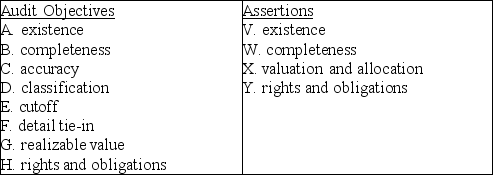Below are five audit procedures, all of which are tests of balances associated with the audit of accounts receivable. Also, below are the eight general balance-related audit objectives and the four management assertions. For each audit procedure, indicate (1) its audit objective, and (2) the management assertion being tested.
 1. Obtain an aged listing of accounts receivable. For a sample of individual customers on the listing, agree the customer's name, amount, and other information with the corresponding information in the accounts receivable master file.
1. Obtain an aged listing of accounts receivable. For a sample of individual customers on the listing, agree the customer's name, amount, and other information with the corresponding information in the accounts receivable master file.
(1) ________
(2) ________
2. Examine details of sales for five days before and five days after year-end to determine whether sales have been recorded in the proper period.
(1) ________
(2) ________
3. Assess the reasonableness of the balance in the allowance for doubtful accounts.
(1) ________
(2) ________
4. Inquire as to whether any accounts receivable have been factored or sold during the period.
(1) ________
(2) ________
5. Inquire as to whether there are any receivables from related parties.
(1) ________
(2) ________
Definitions:
Will
The mental faculty by which an individual decides upon and initiates action, or in legal contexts, a document specifying the distribution of someone's estate after their death.
Annihilate
To destroy completely, leaving nothing remaining.
Anthropologists
Scientists who study human societies, cultures, and their development, often involving field research and comparative analysis.
Q10: The Sarbanes-Oxley Act of 2002 is an
Q16: An example of an analytical procedure performed
Q26: List the five steps in applying materiality
Q58: An auditor who audits a business cycle
Q66: A successor auditor may perform which of
Q89: When using financial ratios, the most important
Q92: Define ordinary negligence, gross negligence, and constructive
Q104: Which part of the AICPA's Code of
Q144: Financial ratios<br>A) are used during the planning
Q175: Auditing standards make _ distinction(s) between the